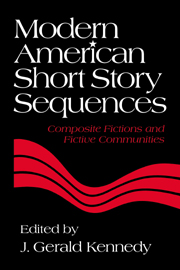Book contents
- Frontmatter
- Contents
- Contributors
- Introduction: The American Short Story Sequence – Definitions and Implications
- Henry James's Incipient Poetics of the Short Story Sequence: The Finer Grain (1910)
- Toomer's Cane as Narrative Sequence
- Hemingway's In Our Time: The Biography of a Book
- Wright Writing Reading: Narrative Strategies in Uncle Tom's Children
- The African-American Voice in Faulkner's Go Down, Moses
- Meditations on Nonpresence: Re-visioning the Short Story in Eudora Welty's The Wide Net
- Nine Stories: J. D. Salinger's Linked Mysteries
- Cheever's Shady Hill: A Suburban Sequence
- John Updike's Olinger Stories: New Light Among the Shadows
- Louise Erdrich's Love Medicine: Narrative Communities and the Short Story Sequence
- From Anderson's Winesburg to Carver's Cathedral: The Short Story Sequence and the Semblance of Community
- Index
Toomer's Cane as Narrative Sequence
Published online by Cambridge University Press: 29 September 2009
- Frontmatter
- Contents
- Contributors
- Introduction: The American Short Story Sequence – Definitions and Implications
- Henry James's Incipient Poetics of the Short Story Sequence: The Finer Grain (1910)
- Toomer's Cane as Narrative Sequence
- Hemingway's In Our Time: The Biography of a Book
- Wright Writing Reading: Narrative Strategies in Uncle Tom's Children
- The African-American Voice in Faulkner's Go Down, Moses
- Meditations on Nonpresence: Re-visioning the Short Story in Eudora Welty's The Wide Net
- Nine Stories: J. D. Salinger's Linked Mysteries
- Cheever's Shady Hill: A Suburban Sequence
- John Updike's Olinger Stories: New Light Among the Shadows
- Louise Erdrich's Love Medicine: Narrative Communities and the Short Story Sequence
- From Anderson's Winesburg to Carver's Cathedral: The Short Story Sequence and the Semblance of Community
- Index
Summary
Jean Toomer's 1923 collage of fiction, poetry, and drama is a sequence of narrative forms riveted together by its title, Cane, The image of the sugar cane is Southern, nourishing, phallic, common, redolent – as Toomer says in his poems – of the Southern agrarian life. In “Georgia Dusk,” his central image is of black men singing “the chorus of the cane … caroling a vesper to the stars.” Cane is also sweet, sensual, and a source of some of the (rare) pleasure in the lives of Toomer's black characters. The noun cane also is a homonym for the Biblical Cain, whose character suggests the bloody destruction of brotherhood and introduces the concept of immoral violence. The image of cane ties the reader to the earth, to the commonplace that was the touchstone of one current of American avant-garde literature in the early 1920s (represented by William Carlos Williams and Robert McAlmon's journal, Contact). Through that resonating image, Toomer creates place, time, and theme. The location is the South, both rural Georgia and urban Washington, D.C.; the time is the present; and one pervasive theme is the pitiful and yet self-defeating way black people live in contemporary America. Cane also explores the sexual lives of the blacks, and much of its narrative is expressed from a male perspective. It therefore fits neatly into mainstream American modernism, which was soon dominated by the writing of Ernest Hemingway, E Scott Fitzgerald, John Dos Passos, and William Faulkner.
For all its similarity to other modernist texts, however, Cane is unique in American literature. In its wide-ranging eclecticism, it goes beyond the provincialism of much American writing.
- Type
- Chapter
- Information
- Modern American Short Story SequencesComposite Fictions and Fictive Communities, pp. 19 - 34Publisher: Cambridge University PressPrint publication year: 1995



